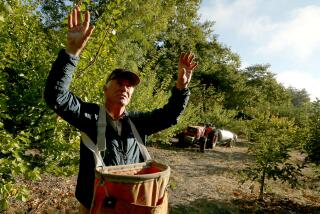Apples : Did You Eat 22 Pounds of Apples Last Year? : Industry recovery: Alar is gone but growers, processors and wholesalers still get skittish whenever the pesticide is mentioned.
- Share via
The apple industry’s worst nightmare was in summer reruns last month.
On Aug. 9, television stations across the country repeated a segment of “Donahue,” taped in March of 1989, that was devoted to the use of the chemical Alar on apples and the resulting public furor.
Quick legal action by a Washington-based trade group forced cancellation of all afternoon broadcasts of the program, even though the morning telecasts were aired without interruption, according to a produce industry publication.
After all, argued the Alexandria, Va.-based International Apple Institute, the issues surrounding Alar were resolved last year, and rebroadcasting the show might only set off a new wave of concern. The producers of “Donahue” agreed and halted further showings of the segment.
Such a fleeting episode illustrates how difficult it has been for apple growers, processors and wholesalers to recover from the events of 18 months ago.
In the industry, 1989 will always be associated with the Natural Resources Defense Council and its study claiming that pesticide residues on produce posed a heightened cancer risk to children. The council focused on Alar, a growth enhancer used on apples, to publicize its case.
And just this month, a report released by the California Public Interest Research Group pointed out that the Environmental Protection Agency never formally banned Alar; it was voluntarily removed from the market by its manufacturer, Uniroyal.
Television and report appearances aside, the overall recovery remains on track. For instance, Consumer Reports magazine, in a recent issue, declared that the “apple controversy (was) over.” Alar is no longer sold in this country, and growers seem to be surviving quite well without it.
Last year, for instance, was the second-largest apple harvest in history with 237 million bushels sent to market, a total surpassed only by 1987’s 255 million.
Projections for 1990 place the U.S. crop at 220 million bushels, down somewhat from initial federal estimates, but still one of the decade’s best seasons. (About 50% of the total is sold as fresh produce while the remainder is processed into other products.)
“Consumers are buying more apples than ever before,” said Chuck St. John, spokesman for the Washington Apple Commission in Wenatchee, Wash. “Consumer demand couldn’t be better.”
Quoting federal statistics, St. John says that Americans each ate about 22 pounds of apples in the 12 months ending July 1, for the highest consumption rate in 30 years.
Although a few dozen apple varieties are grown commercially in the United States, five types constitute the bulk of the harvest. The most popular apples, based on annual production, are Red Delicious, Golden Delicious, Granny Smith, McIntosh and Rome Beauty.
In fact, if the industry has one real problem today, it is too much fruit.
“We have been fighting an oversupply of apples for a long time,” said Stephen M. Wood, president of the New Hampshire Fruit Growers Assn. “There are no signs of national production tapering off dramatically, despite orchards on both coasts and in the Middle West going out of business.”
Wood, who owns and works orchards in West Lebanon, N.H., said improved production practices are responsible for the increasing yields on diminishing acreage.
St. John agrees that the record harvests haven’t helped the growers’ bottom line much.
“The dramatic growth has put a strain on the industry’s management of crops. Prices paid to the growers have suffered as a result,” he said.
A positive trend, however, is the interest being expressed in new apple varieties, according to Wood.
“There are more and more people planting non-traditional varieties on a commercial scale,” he said, mentioning such exotic apples as Fuji, Braeburn, New Zealand’s Gala and Washington State’s Jonagold.
There is even a sense, Wood says, of the industry moving away from the Red Delicious, which constitutes 50% of the total United States harvest.
“Growers are not abandoning the Red Delicious, but there is a limit to how many can be sold,” he said. “The market for them is not what it was five years ago, nor 10 years ago.”
St. John disagrees with any projected popularity decline for the Red Delicious, Washington’s mainstay variety. He says the fruit has been America’s “apple of preference” for 40 years.
Experimentation is under way, St. John concedes, but he says it is hampered by the fact that each variety is fickle, thriving in only certain climates, thus limiting rapid expansion.
Another interesting development in New England, Woods noted, is experimentation with antique varieties, or those apples that fell out of favor with commercial growers. Some of these strains go back to Revolutionary War times.
“We are getting it into the consumer’s mind that not all apples are red and shiny,” he said.
An obstacle to any major overhaul of the supermarket apple counter is down the road. Wood says it takes at least five years for trees to first bear fruit, even with the help of shortcut methods such as grafting new varieties onto older tree trunks.
“We’re planting trees; not seeds,” Wood said. “It is years before (the grower) finds out if he was right about a particular variety.”
Virtually all apples grown in this country are harvested in the late summer and early fall. The fruit is available throughout the year because of controlled-atmosphere storage. This refrigeration process reduces the oxygen available and thus halts the apples’ natural maturation. According to St. John, some varieties can be stored for as long as 12 months in this condition without any appreciable loss in “crunch, flavor or sugar” from just-picked fruit.
More to Read
Inside the business of entertainment
The Wide Shot brings you news, analysis and insights on everything from streaming wars to production — and what it all means for the future.
You may occasionally receive promotional content from the Los Angeles Times.










